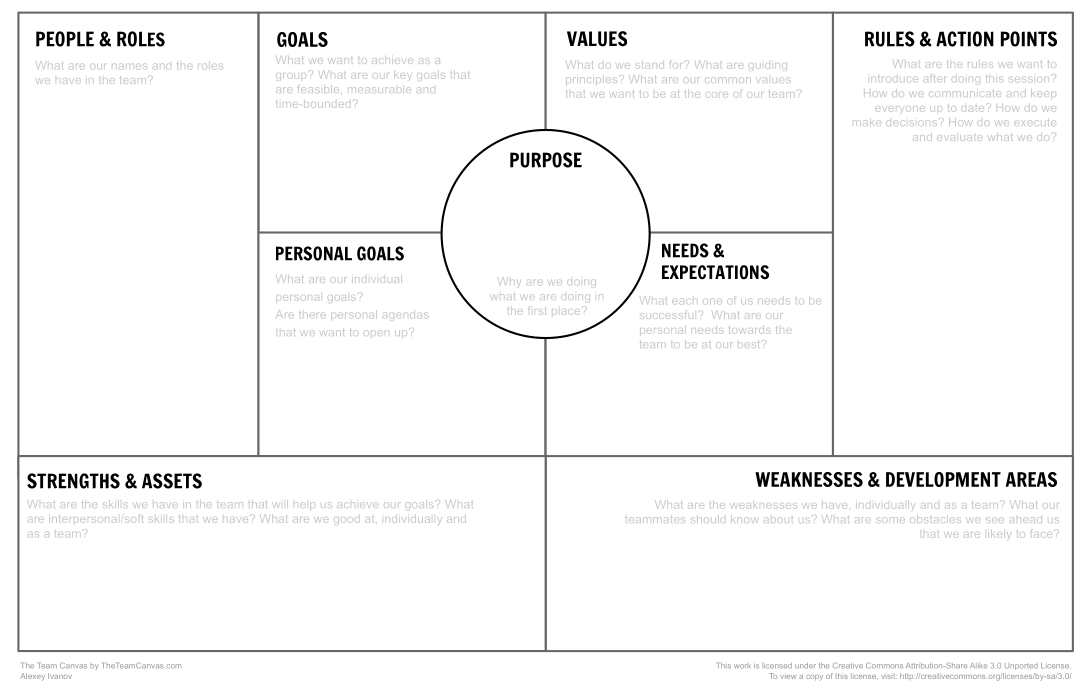Team Canvas preparation hints
About these hints
With recent Team Canvas exercises I facilitated, I found that there is usually not enough time to go through the different phases without having some discussion cut short.
By giving people an overview of the different areas and letting them think about this up-front, you can reduce the time needed for people to think and write down notes, which leaves more time for actual discussion and team reflection.
The following is a copy of the preparation material I have started handing out ahead of Team Canvas sessions.
Preparation
During the Team Canvas session, we’ll go through all the sections from the frame below, with people having a couple of minutes to write down their points, followed by discussion of the items everyone put up. In order to speed this up, it’s helpful to come prepared, knowing what you’ll wish to write down on the stickies during the different phases.
Warning
Please keep your notes private until the event itself, so as not to influence others too much.

The prompts below may help you to figure out what to write down for each section.
People & Roles
What do you see as your role in our team? This would typically be your official job title, but you can also divide this into more specific elements if you feel that makes sense (this is especially applicable to people with long tenure and/or coming from different internal departments).
Common goals
What are the goals that you personally feel we as a group should really want to achieve the coming year? What should we pursue or work on?
During the meeting we’ll see what everybody came up with and try to reach consensus/a common theme.
Personal goals
What are your personal goals for the coming year? What are you passionate about, what do you hope to achieve for yourself?
Purpose
Going a step beyond our concrete goals, looking more at an overall vision: What do you feel is the purpose of our team? Why are we here? How do we help accomplish Castor’s overall mission?
It’s okay to reuse the purpose we identified in our last team canvas, if you still feel it applies. But ideally, write down what you feel our purpose should be, and we’ll use the time together to find the common thread.
Values
What are our core values, our guiding principles which govern how we behave and make decisions?
Helpful questions to ask yourself:
- What do we stand for?
- What are our guiding principles?
- What are some common values that we want to be at the core of our team?
These don’t need to be highly polished. In fact, concise ideals like “Trust”, “Transparency”, “Respect”, etc. are the best place to start from, but they can be wordier too, like “Minimize toil by automating repetitive tasks”.
Strengths & Assets
What are your personal strengths? What key technical skills do you bring to our team? Both hard and soft skills apply here. Interpret this broadly and don’t be afraid to make this personal to you.
Helpful questions to ask yourself:
- What are the skills we have in the team that will help us to achieve our goals?
- What are interpersonal/soft skills that we have?
- What are we good at, individually and as a team?
It’s also okay to point out strengths you recognize in your team members here.
Weaknesses & Development Areas
In inverse of the previous section, every strength has associated weaknesses. What do you recognize as areas you could still improve in? What type of work or situations do you find challenging? What obstacles do you believe we’ll face with our team composition?
This should be focused on either yourself, or the team as a whole in a general sense. This is not about actively pointing out flaws in your fellow team members.
Helpful questions to ask yourself:
- What are the weaknesses we have, individually and as a team?
- What should our team members know about us?
- What are some obstacles we see ahead of us that we are likely to face?
Needs & Expectations
What do you need to be successful at your job? What will allow you to be your best self and the most productive?
Think of this as a follow up to previous two sections: once you’ve identified your strengths and weaknesses, you should be able to express the needs you have to amplify your strengths and mitigate your weaknesses.
Helpful questions to ask yourself:
- What do you need to be successful at your job?
- How can others on the team help you with these needs?
- Are you quiet or outspoken? Do you enjoy long social interactions, or are you more of a quiet type who prefers moments of deep focus? Will you naturally ask for help or do you need others to incentivize you when you appear stuck?
- Are there any team agreements or habits we could introduce to help offset our weaknesses?
Rules & Activities
Think of this as the final outcome of all the previous sections. We know what we’re trying to achieve and we know our strengths and weaknesses; What framework of rules, activities and conventions will help us maximize our potential while mitigating our weaknesses?
Helpful questions to ask yourself:
- What are the rules we want to introduce after doing this session?
- How do we plan our work?
- How do we communicate and keep everyone up to date?
- How do we make decisions?
- Are there any habits we can adopt to ensure people’s needs and expectations are met?